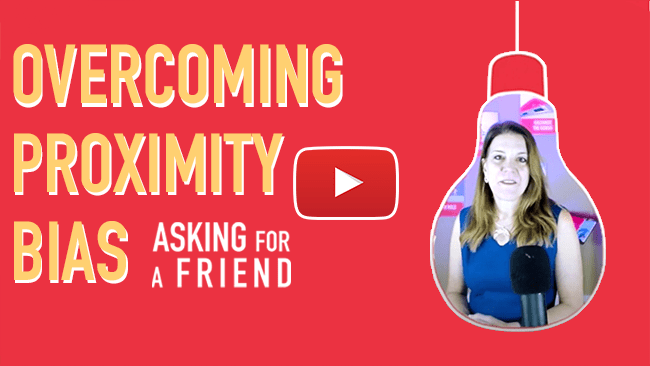Is proximity bias really a thing? #askingforafriend
Karin, with our new work-from-home policy, and flexible work arrangements, I have some of my team working from home most of the time. And, other team members are choosing to come into the office (as am I). How do I ensure I don’t give preferential treatment to the people I see most often? How do I prevent this thing called proximity bias #AskingforaFriend.

1. Talk about proximity bias WITH your team.
You could start the proximity bias conversation like this.
“We want to create an inclusive work environment where we respect, value, and support every team member no matter where they choose to work. What’s working now? What’s getting in the way?”
2. Be thoughtful and deliberate in your one-on-ones
There’s no better way to know what’s really on your employees’ hearts and minds than a truly great approach to one-on-ones. Take time for creating clarity and removing roadblocks, building genuine connection, and proactively asking them for their ideas.
3. Lead your meetings from both sides of the hybrid table to avoid proximity bias
If you primarily lead meetings from a physical office with remote members dialing in, try leading your meeting from a remote location from time to time while others are still gathered in the conference room.
Giving yourself the experience of remote participation will also help you be mindful of creating a common, shared experience (eg: avoiding side-bar conversations or inside jokes that don’t include everyone – this is one reason many hybrid team leaders move to a “one screen-one face” approach, even for those in person.)
4. Be purposeful with your time together
If it’s feasible to bring your team together in person, consider the most important work to accomplish during that time (e.g. strategic planning, raising ideas, sharing concerns, building trust, gaining exposure to executives, navigating tough performance conversations). And if you require in-person days, ask your team what would make that time most worth the commute.
5. Measure it
If you’re serious about overcoming proximity bias, you need to know when it’s happening. Just like other unconscious biases, it’s important to measure behavior.
One easy way to do this is to keep a list of each member of your team and track your interactions. For example, you might track the time and duration of one-on-ones, informal conversations, and other meetings. Then, look or the patterns.









0 Comments